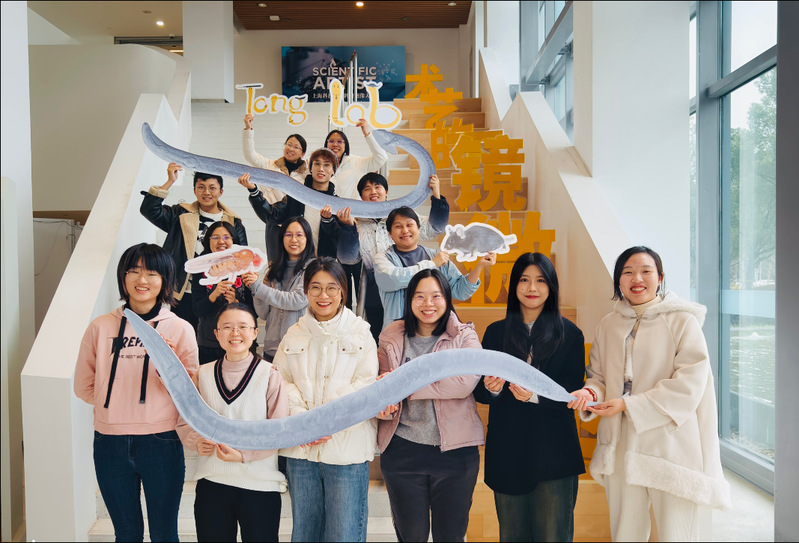Principal investigator
Name:
Xiajing TongAssociate Professor , PhD, Associate Professor
Position:
Affiliation:
School of Life Science and Technology
Honor:
Education Background:
- 2001/09-2005/07, University of Science and Technology of China, Bachelor
- 2005/09-2010/07, Institute of Biochemistry and Cell Biology, Chinese Academy of Sciences, Ph.D.
Working Experience:
- 2010/08-2011/08, Institute of Biochemistry and Cell Biology, Chinese Academy of Sciences, Research Assistant
- 2011/09-2016/05, Harvard Medical School/Mass General Hospital, Postdoc
- 2016/06-2017/07, Harvard Medical School/Mass General Hospital, Research Associate
- 2017/08-2023/10, ShanghaiTech University, Assistant Professor
- 2023/10-Now, ShanghaiTech University, Associate Professor
Group Introduction
Research Area:
neurobiology, sexual dimorphism, synaptic transmission
Research Interests:
Biological sex has a profound impact on animal behaviors, including mate-seeking, courtship, and parental care, all of which are critical for survival and reproduction. Moreover, many psychiatric and neurological disorders exhibit sexually dimorphic patterns of prevalence. For instance, males are more likely to be diagnosed with Autism Spectrum Disorder (ASD), while females are more prone to Major Depressive Disorder (MDD). Despite these well-established sex differences in behavior and disease susceptibility, the molecular and cellular mechanisms that drive these disparities remain poorly understood.
Our research uses multiple model organisms, including C. elegans, Drosophila, and mice, to address the knowledge gap in understanding the molecular and cellular mechanisms underlying sexually dimorphic synaptic transmission. By investigating sex-specific differences in locomotion behavior and neurodegeneration, we aim to uncover variations in synaptic activity and neural circuitry between males and females. Ultimately, our work will enhance our understanding of the biological basis of sex-specific behaviors and their connection to sex-biased diseases.
Research Achievement
Genetic Contributions Sexually Dimorphic Cholinergic Transmission at C. elegans NMJs Mediates Sex-Specific Locomotion Behaviors In C. elegans, there are two sexes: somatic female hermaphrodites and males. These two sexes exhibit distinct motor behaviors, with males showing faster locomotion velocities and more pronounced body wave curvatures compared to hermaphrodites. Our study reveals sexually dimorphic cholinergic synaptic transmission at the neuromuscular junctions (NMJs), with males exhibiting increased synaptic release frequencies. Scanning electron microscopy further demonstrated that males have significantly more synaptic vesicles (SVs) at their cholinergic synapses compared to hermaphrodites that is mediated by CaMKII. Thus, beyond demonstrating UNC-43/CaMKII as an essential mediator of sex-specific synaptic transmission, our study provides molecular and cellular insights into how sex-shared neurons can generate sexually dimorphic locomotion behaviors. ( J Cell Biol., 2023). Presynaptic CaMKII Triggers Anterograde Signaling to Recruit GABAARs A key mechanism for modulating inhibitory synaptic transmission and plasticity is the regulation of postsynaptic GABA receptor (GABAAR) abundance. Recent studies, including our own, have shown that GABAARs are stabilized by distinct scaffolds at C. elegans NMJs, including the synaptic adhesion molecule NLG-1/Neuroligin and the FERM domain-containing protein FRM-3 (Elife, 2015; PLOS Genetics, 2023). In this study, we identify UNC-43/CaMKII, the C. elegans ortholog of CaMKII, as a crucial factor in initiating anterograde signals (MADD-4B/Punctin and NRX-1α) that recruit postsynaptic GABAARs, modulating inhibitory synaptic transmission. Our findings provide new insights into how presynaptic neurons transsynaptically recruit postsynaptic receptors during synaptogenesis and activity-dependent plasticity (Nature Communications, 2023).
Environmental Contributions Male Pheromones Modulate Cholinergic Transmission at Hermaphrodite NMJs We show that male-specific pheromones (ascarosides) increase cholinergic synaptic transmission at the NMJs in C. elegans in a sex-specific manner—specifically in hermaphrodites. This pheromone-mediated modulation of cholinergic transmission is developmental stage-dependent. Upon detection, AWB neurons utilize cGMP signaling to relay the information to NMJs. Furthermore, we find that activation of AWB neurons during the early developmental stages (L3-L4) is both necessary and sufficient to modulate cholinergic transmission at NMJs. These findings provide new insights into how animals sense and adapt to their social environments, highlighting the role of pheromones in regulating development and behavior (Elife, 2021; Journal of Cell Science, 2022). Pheromone Exposure During Early Development Promotes Neurodegeneration in Adults Neurodegenerative diseases have significant environmental components, including exposure to chemical cues. In C. elegans, we found that exposure to specific pheromones (ascr#3 and ascr#10) during the early developmental stage (L1) remodels neurodevelopment and accelerates α-synuclein-induced neurodegeneration in adult hermaphrodites. We identified two pairs of chemosensory neurons, ASK and ASI, that mediate the perception of ascr#3 and ascr#10, respectively. Activation of both ASI and ASK neurons during the L1 stage is sufficient to remodel neurodevelopment through AIA interneurons, which trigger insulin-like signaling and inhibit autophagy in adult neurons in a non-cell-autonomous manner. Our work uncovers a mechanism by which pheromone perception during early development influences neurodevelopment and alters autophagy and proteotoxicity-induced neurodegeneration in adulthood. These findings offer important insights into how environmental factors influence the progression of neurodegenerative diseases (Cell Reports, 2023).
Representative Publications (*First Author, # Corresponding Author)
- 1. Qian Li*, Yufeng Pan, Xia-Jing Tong.Sexual dimorphism in pheromone perception across worms, flies, and rodents.TRENDS IN NEUROSCIENCES. Nov 2025.
- 2. Ming-Han Wang*; Yue Hao*; Xia-Jing Tong.Targeting the intracellular neurexin interactome by in vivo proximity ligation.TRENDS IN NEUROSCIENCES. 06 Mar 2024. 47(4):243-245.
- 3. Hankui Cheng*; Du Chen*; Xiao Li*; Umar Al-Sheikh; Duo Duan; Yuedan Fan; Linhui Zhu; Wanxin Zeng; Zhitao Hu; Xiajing Tong; Guohua Zhao; Yongming Zhang; Wenjuan Zou; Shumin Duan; Lijun Kang.Phasic/tonic glial GABA differentially transduce for olfactory adaptation and neuronal aging.NEURON. 01 May 2024. 112(9):1473-1486.e6.
- 4. Wan-Xin Zeng*, Haowen Liu*, Yue Hao*, Kang-Ying Qian, Fu-Min Tian, Lei Li, Bin Yu, Xian-Ting Zeng, Shangbang Gao, Zhitao Hu#, and Xia-Jing Tong#.CaMKII mediates sexually dimorphic synaptic transmission at neuromuscular junctions in C. elegans.JOURNAL OF CELL BIOLOGY. Aug 2023. 222(11).
- 5. Peng, Jing-Yi*; Liu, Xuqing*; Zeng, Xian-Ting; Hao, Yue; Zhang, Jia-Hui; Li, Qian; Tong, Xia-Jing#.Early pheromone perception remodels neurodevelopment and accelerates neurodegeneration in adult C. elegans.CELL REPORTS. 27 June 2023. 42(6):112598.
- 6. Hao, Yue*; Liu, Haowen*; Zeng, Xian-Ting; Wang, Ya; Zeng, Wan-Xin; Qian, Kang-Ying; Li, Lei; Chi, Ming-Xuan; Gao, Shangbang; Hu, Zhitao; Tong, Xia-Jing#.UNC-43/CaMKII-triggered anterograde signals recruit GABAARs to mediate inhibitory synaptic transmission and plasticity at C. elegans NMJs.NATURE COMMUNICATIONS. 15 Mar 2023. 14(1):1436.
- 7. Li, Lei*; Liu, Haowen*; Qian, Kang-Ying*; Nurrish, Stephen*; Zeng, Xian-Ting; Zeng, Wan-Xin; Wang, Jiafan; Kaplan, Joshua M.; Tong, Xia-Jing; Hu, Zhitao.CASK and FARP localize two classes of post-synaptic ACh receptors thereby promoting cholinergic transmission.PLOS GENETICS. 24 Oct 2022. 18(10).
- 8. Song, Chun-Xue*; Zeng, Xian-Ting; Zeng, Wan-Xin; Liu, Rong; Tong, Xia-Jing; Li, Qian.A WDR47 homolog facilitates ciliogenesis by modulating intraflagellar transport.JOURNAL OF CELL SCIENCE. 01 Dec 2022. 135(24).
- 9. Qian, Kang-Ying*; Zeng, Wan-Xin; Hao, Yue; Zeng, Xian-Ting; Liu, Haowen; Li, Lei; Chen, Lili; Tian, Fu-Min; Chang, Cindy; Hall, Qi; Song, Chun-Xue; Gao, Shangbang; Hu, Zhitao; Kaplan, Joshua M; Li, Qian; Tong, Xia-Jing.Male pheromones modulate synaptic transmission at the C. elegans neuromuscular junction in a sexually dimorphic manner.ELIFE. 31 Mar 2021. 10.
- 10. Tong, Xia-Jing*; Lopez-Soto, Eduardo Javier; Li, Lei; Liu, Haowen; Nedelcu, Daniel; Lipscombe, Diane; Hu, Zhitao; Kaplan, Joshua M..Retrograde Synaptic Inhibition Is Mediated by alpha-Neurexin Binding to the alpha 2 delta Subunits of N-Type Calcium Channels.NEURON. 2017. 95(2):326.
- 11. Tong, Xia-Jing*; Hu, Zhitao*; Liu, Yu; Anderson, Dorian; Kaplan, Joshua M..A network of autism linked genes stabilizes two pools of synaptic GABA(A) receptors.ELIFE. 2015. 4.
- 12. Hu, Zhitao*; Tong, Xia-Jing; Kaplan, Joshua M..UNC-13L, UNC-13S, and Tomosyn form a protein code for fast and slow neurotransmitter release in Caenorhabditis elegans.ELIFE. 2013. 2.
- 13. Hu, Zhitao*; Hom, Sabrina; Kudze, Tambudzai; Tong, Xia-Jing; Choi, Seungwon; Aramuni, Gayane; Zhang, Weiqi; Kaplan, Joshua M..Neurexin and Neuroligin Mediate Retrograde Synaptic Inhibition in C. elegans.SCIENCE. 2012. 337(6097):980-984.
- 14. Zhang, Ming-Liang*; Tong, Xia-Jing*; Fu, Xiao-Hong; Zhou, Bo O.; Wang, Jianyong; Liao, Xin-Hua; Li, Qian-Jin; Shen, Ning; Ding, Jianping; Zhou, Jin-Qiu.Yeast telomerase subunit Est1p has guanine quadruplex-promoting activity that is required for telomere elongation.NATURE STRUCTURAL & MOLECULAR BIOLOGY. 2010. 17(2):202.
- 15. Tong, Xia-Jing*; Li, Qian-Jin; Duan, Yi-Min; Liu, Ning-Ning; Zhang, Ming-Liang; Zhou, Jin-Qiu.Est1 Protects Telomeres and Inhibits Subtelomeric Y '-Element Recombination.MOLECULAR AND CELLULAR BIOLOGY. 2011. 31(6):1263-1274.
- 16. Duan, Yi-Min*; Zhou, Bo-O.; Peng, Jing; Tong, Xia-Jing; Zhang, Qiong-Di; Zhou, Jin-Qiu.Molecular dynamics of de novo telomere heterochromatin formation in budding yeast.JOURNAL OF GENETICS AND GENOMICS. 20 Jul 2016. 43(7):451-465.
- 17. Hu, Yan*; Tang, Hong-Bo*; Liu, Ning-Ning*; Tong, Xia-Jing; Dang, Wei; Duan, Yi-Min; Fu, Xiao-Hong; Zhang, Yang; Peng, Jing; Meng, Fei-Long; Zhou, Jin-Qiu.Telomerase-Null Survivor Screening Identifies Novel Telomere Recombination Regulators.PLOS GENETICS. 2013. 9(1).
- 18. Li, Qian-Jin*; Tong, Xia-Jing; Duan, Yi-Min; Zhou, Jin-Qiu.Characterization of the intramolecular G-quadruplex promoting activity of Est1.FEBS LETTERS. 2013. 587(6):659-665.
- 19. Chang, Yuanyuan*; Wu, Jian; Tong, Xia-Jing; Zhou, Jin-Qiu; Ding, Jianping.Crystal structure of the catalytic core of Saccharomyces cerevesiae histone demethylase Rph1: insights into the substrate specificity and catalytic mechanism.BIOCHEMICAL JOURNAL. 2011. 433:295-302.
- 20. Meng, Fei-Long*; Hu, Yan; Shen, Ning; Tong, Xia-Jing; Wang, Jianyong; Ding, Jianping; Zhou, Jin-Qiu.Sua5p a single-stranded telomeric DNA-binding protein facilitates telomere replication.EMBO JOURNAL. 2009. 28(10):1466-1478.
- 21. 童夏静*; 周金秋.端粒和端粒酶的发现及其生物学意义.生命科学. Dec 2009. 21(6):760-769.
Awards
- 1. 2024, GENETICS, Associate editor
Group Member and Photo
-
Name:Xianting Zeng
Position:Engineer
Duration:
Email:
-
Name:Wanxin Zeng
Position:Postgraduate Student
Duration:2018/02-Now
Email:
-
Name:Yue Hao
Position:Postgraduate Student
Duration:2019/02-Now
Email:
-
Name:Jingyi Peng
Position:Postgraduate Student
Duration:2020/02-Now
Email:
-
Name:Minghan Wang
Position:Postgraduate Student
Duration:2021/02-Now
Email:
-
Name:Jiahui Zhang
Position:Postgraduate Student
Duration:2021/02-Now
Email:
-
Name:Jian He
Position:Postgraduate Student
Duration:2021/02-Now
Email:
-
Name:Chunxue Song
Position:Visiting Student
Duration:2018/11-Now
Email:
-
Name:Chengxi Li
Position:Postgraduate Student
Duration:2022/02-Now
Email:
-
Name:Guanyu Peng
Position:Postgraduate Student
Duration:2023/02-Now
Email:
-
Name:Kailiang Zhang
Position:Postgraduate Student
Duration:2023/01-Now
Email:
|




